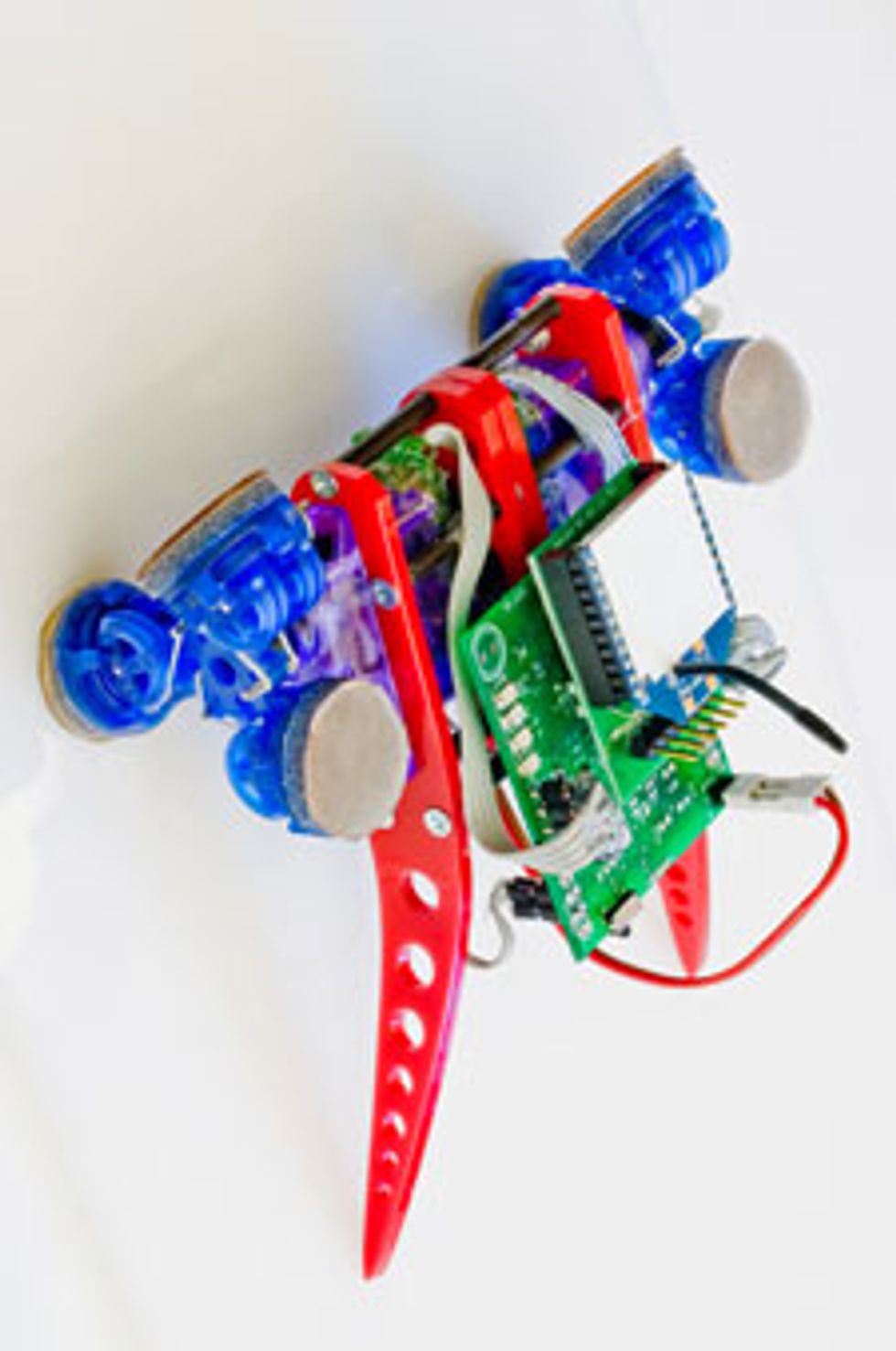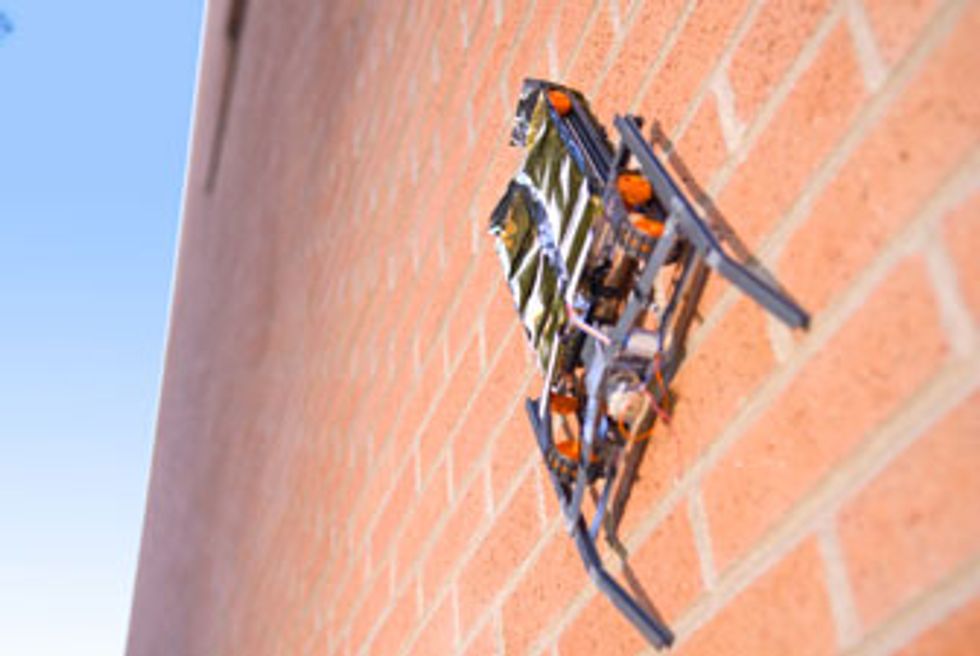21 May 2008--Roboticists have already made robots that can race across rugged terrain, explore space or aquatic environments, and even take wing. At the 2008 IEEE International Conference on Robotics and Automation (ICRA 2008) this week, in Pasadena, Calif., engineers are presenting the latest takes on how to tackle a new frontier: vertical surfaces.
”[We're] trying to get robots to go places that they haven't been able to go before, and climbing is a kind of new territory for four-legged robots,” says Mark Cutkosky, a mechanical engineering professor at Stanford University.
Wall-climbing bots could scale buildings or creep up windows, secretly spying for hours. They could also be used for search-and-rescue operations. More benignly, they could inspect and repair the hard-to-reach parts of airplanes, spacecraft, and bridges.
Cutkosky and his doctoral student Sangbae Kim get their inspiration from geckos. The bottom of a gecko's foot is covered with billions of fibers with 200-nanometer-wide tips. The lizards can stick to any surface because of a weak intermolecular attraction known as Van der Waals force, which acts between the fiber tips and the surface the gecko is climbing. The adhesion is directional: the fibers stick only when the toes drag downward, and they release in the opposite direction.
To emulate the gecko's dry adhesive, the researchers created polymer patches covered with tiny stalks about 30-micrometers wide. The stalks are angled and have oblique tops, which give them directional stickiness. The patches go on the toe pads of a robot that Cutkosky and Kim have endowed with a gecko's gait, curling toes, and other details. The original version, built two years ago, crawled up smooth surfaces such as glass and glazed tile at a speed of 4 centimeters per second [see video "Stanford's Stickybot"].
The researchers are refining the technology to build robots that can climb a wide range of surfaces. At ICRA 2008, they will show that their bot can climb up overhangs. Eventually, says Cutkosky, the robot will conquer ceilings too. ”What we realize now is [that] the whole process of how you control the robot is [by] simultaneously controlling forces and orientations of the feet,” Cutkosky says. The most recent version of the robot cannot generate the right combination of forces between its feet or rotate its feet to scurry across a ceiling--those are improvements the researchers plan to work on. But by simply attaching its rear foot backward, the robot can climb up a 20-degree overhang.
WAALBOT
Carnegie Mellon's adhesive-enhanced wall crawler.
The researchers are also designing adhesive pads that would work on rough surfaces. The goal is to more closely copy the nanometer-scale features and the complex structure of the gecko's toe, which has ridges topped with rows of nanoscale fibers, each split into even smaller spatula-like filaments.
At Carnegie Mellon University, gecko-inspired robots are already climbing rough surfaces such as painted walls, wooden doors, and bricks, and can even turn corners. Metin Sitti, an associate professor with CMU's mechanical engineering department and the Robotics Institute, and his associates will present its adhesive design for rough surfaces at ICRA 2008.
Sitti's team uses a micromolding technique to make polymer fibers 28 to 57 micrometers wide. Then they dip the fibers into liquid polymer to make tiny spatula-like tips. They are now trying to make much smaller fibers, which would mean stronger adhesion and have managed to go as narrow as 2 micrometers.
Researchers at Menlo Park, Calif.�based SRI International are taking a different approach to wall climbing. Their robot, which will make its debut at ICRA 2008, uses electrostatic forces to clamp to a vertical surface. Senior research engineer Harsha Prahlad and his colleagues retrofitted a toy tank robot by putting thin, soft overlapping flaps on its tread. A small power supply on board makes one tread positively charged and the other negative. The treads' electric fields draw opposite charges to the surface directly under them, pulling the treads toward the surface. The soft flaps conform around surface roughness, allowing the robot to climb up concrete and wood in addition to smooth glass [see video "Electrostatic Wall-Crawler"].
Prahlad says there are advantages to electrostatic adhesive technology. It does not require complex fabrication, and it could be adapted for any existing wheeled or treaded robot. And it's strong: on an ideal surface such as clean glass, a square centimeter of the clamp can carry 70 grams. Perhaps the biggest advantage is that it works despite dirt and dust without needing repeated washing or replacement [see video "Climbing Through Dust"]. While the gecko-inspired adhesives get clogged with dirt, the SRI robot rolls right through it. And even if dust does stick to the flaps, removing it would be easy, Prahlad says: ”We can simply switch it off.”
Electroadhesion does have the disadvantage of needing power to keep the robot clinging to a wall. Prahlad says the technology requires about 220 microwatts for each kilogram of robot.
The wall climbers will need to have much stronger adhesion if they are to carry sensors and transmitters for spying and surveillance. For now, Cutkosky is thinking about other uses where the size and mobility of the robot would not need to be as complicated. ”They could have manufacturing applications where you have to handle large, smooth fragile objects like maybe plasma screens,” he says.
STATIC CLINGER
Conductive foil on the treads of SRI International's wall-climbing robot form an electrostatic bond with the wall.

